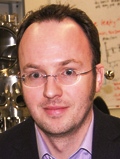Awardee Interviews | Biography: Charles Skyes
Charles Skyes

Dr. E. Charles H. Sykes, Tufts University, “for pioneering atomic-scale studies of chirality, catalysis, and molecular rotation”
E. Charles H. Sykes is currently an Associate Professor of Chemistry at Tufts University. Charles got a first class B.S. and M.S. from Oxford University before moving to Cambridge University for a Ph.D. under the supervision of Professor Richard Lambert. His thesis work explored the structure and reactivity of model gold/titania catalysts. He then relocated to the U.S. for postdoctoral fellowships with Professor Paul Weiss at Penn State and Professor Mike Fiddy at the University of North Carolina at Charlotte. His postdoctoral studies were the first to directly image and control the placement of catalytically important subsurface hydrogen in palladium. In 2005 Charles began his independent career as an Assistant Professor of Chemistry at Tufts University.
The Sykes group utilizes state of the art scanning probes and surface science instrumentation to study fundamentally and technologically important systems. For example, scanning tunneling microscopy enables visualization of the geometric and electronic properties of catalytically relevant metal alloy surfaces at the nanoscale. Using temperature programmed reaction studies of well-defined model catalyst surfaces structure-property-activity relationships are drawn. The Sykes group recently demonstrated how single palladium atoms can convert the otherwise catalytically inert surface of an inexpensive metal into an ultraselective hydrogenation catalyst. The mechanism involves facile dissociation of molecular hydrogen at individual palladium atoms followed by spillover onto the copper surface, where ultraselective catalysis occurs by virtue of weak binding. The reaction selectivity is in fact much higher than that measured on palladium alone, illustrating the unique synergy of the system.
In the area of molecular motors, the Sykes group has demonstrated the world’s first single molecule electric motor. Electrons from a scanning tunneling microscope tip were used to drive the directional motion of a thioether molecule on a copper surface. Surprisingly, the direction and rate of the rotation turned out to be related to the chirality of both the molecule and the tip of the microscope (the electrode), illustrating that the exact geometry and chirality of electrical contacts to molecules can have a large influence on excitation probability, a fact overlooked in all nanoscale electrical devices to date.
Charles has been named a Beckman Young Investigator, Research Corporation Cottrell Scholar, IUPAC Young Observer and the Usen Family Career Development Assistant Professor. He is also the recipient of an NSF CAREER award and a Camille Dreyfus Teacher-Scholar Award. He is the author of over 55 peerreviewed publications and has given over 50 invited talks at conferences and universities.